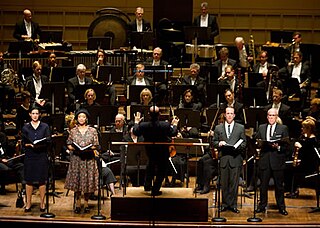Related Research Articles

Rhapsody in Blue is a 1924 musical composition written by George Gershwin for solo piano and jazz band, which combines elements of classical music with jazz-influenced effects. Commissioned by bandleader Paul Whiteman, the work premiered in a concert titled "An Experiment in Modern Music" on February 12, 1924, in Aeolian Hall, New York City. Whiteman's band performed the rhapsody with Gershwin playing the piano. Whiteman's arranger Ferde Grofé orchestrated the rhapsody several times including the 1924 original scoring, the 1926 pit orchestra scoring, and the 1942 symphonic scoring.

The Rhapsody on a Theme of Paganini, Op. 43, is a concertante work written by Sergei Rachmaninoff for piano and orchestra, closely resembling a piano concerto, all in a single movement. Rachmaninoff wrote the work at his summer home, the Villa Senar in Switzerland, according to the score, from 3 July to 18 August 1934. Rachmaninoff himself, a noted performer of his own works, played the piano part at the piece's premiere on 7 November 1934, at the Lyric Opera House in Baltimore, Maryland, with the Philadelphia Orchestra conducted by Leopold Stokowski.

A piano concerto, a type of concerto, is a solo composition in the classical music genre which is composed for piano accompanied by an orchestra or other large ensemble. Piano concertos are typically virtuosic showpieces which require an advanced level of technique. Piano concertos are typically written out in music notation, including sheet music for the pianist, orchestral parts, and a full score for the conductor.

George Enescu, known in France as Georges Enesco, was a Romanian composer, violinist, conductor, and teacher and is regarded as one of the greatest musicians in Romanian history.
Concerto in F is a composition by George Gershwin for solo piano and orchestra which is closer in form to a traditional concerto than his earlier jazz-influenced Rhapsody in Blue. It was written in 1925 on a commission from the conductor and director Walter Damrosch. It is just over half an hour long.
Emil Grigoryevich Gilels was a Soviet pianist. He is widely regarded as one of the greatest pianists of all time.

Ernst von Dohnányi was a Hungarian composer, pianist and conductor. He used a German form of his name on most published compositions.

Giuseppe Martucci was an Italian composer, conductor, pianist and teacher. Sometimes called "the Italian Brahms", Martucci was notable among Italian composers of the era in that he dedicated his entire career to absolute music, and wrote no operas. As a composer and teacher he was influential in reviving Italian interest in non-operatic music. Nevertheless, as a conductor, he did help to introduce Wagner's operas to Italy and also gave important early concerts of English music there.

Steven Edward Stucky was a Pulitzer Prize-winning American composer.

Frederick Shepherd Converse, was an American composer of classical music, whose works include four operas and five symphonies.
D minor is a minor scale based on D, consisting of the pitches D, E, F, G, A, B♭, and C. Its key signature has one flat. Its relative major is F major and its parallel major is D major.

American Rhapsody was written for the accordion by John Serry Sr. in 1955 and subsequently transcribed for the free-bass accordion in 1963 and for the piano in 2002. The composer was inspired by the classical orchestral works of George Gershwin along with various Latin jazz percussive rhythms utilized throughout South America while composing this opus.

Hungarian Rhapsody No. 2 in C-sharp minor, S.244/2, is the second in a set of 19 Hungarian Rhapsodies by composer Franz Liszt, published in 1851, and is by far the most famous of the set.

Frédéric Chopin wrote 21 nocturnes for solo piano between 1827 and 1846. They are generally considered among the finest short solo works for the instrument and hold an important place in contemporary concert repertoire. Although Chopin did not invent the nocturne, he popularized and expanded on it, building on the form developed by Irish composer John Field.
Hungarian Rhapsody No. 8, S.244/8, in F-sharp minor, is the eighth Hungarian Rhapsody composed by Franz Liszt for solo piano. It was composed in 1847 and published in 1853. It has been nicknamed "Capriccio". It utilizes a melody of Hungarian folk song Káka tövén költ a ruca in the slow section. The allegro motif was also used by Liszt in his symphonic poem Hungaria (1856).
Prelude in E-flat major is a 1924 piece for piano solo by the English composer John Ireland. A performance takes 5 to 6 minutes.
Rhapsody is a 1915 piece for piano solo by the English composer John Ireland.
References
- 1 2 John Ireland: First Rhapsody, for piano in C sharp major at AllMusic . Retrieved 1 May 2015.
- ↑ "List of works – E to F". The John Ireland Trust. Archived from the original on 27 July 2012. Retrieved 1 May 2015.
- 1 2 "John Ireland – the solo piano music Volume 3". Mark Bebbington. Archived from the original on 10 January 2015. Retrieved 1 May 2015.
- ↑ "First Rhapsody in C#, for piano". Classical Archives. Retrieved 1 May 2015.